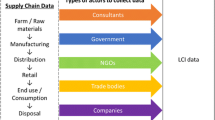Abstract
Purpose
This paper presents the implementation of O-LCA by a Brazilian cosmetics manufacturer. The case study was developed within the framework of the road testing of the “Guidance on organizational LCA” of the UNEP/SETAC Life Cycle Initiative. The aim is to illustrate methodological choices and implementation challenges encountered by the company, i.e., related to the broad product portfolio. The study demonstrates that O-LCA allows quantifying and managing environmental impacts throughout global supply chains and for every individual product.
Methods
O-LCA provides the methodological framework for applying LCA to organizations, and a set of application options based on the structure and experience of organizations. The reporting organization is NATURA Brazil in 2013. The 2600 products in the portfolio are modeled in this first exercise of the company through the bestsellers at each of its ten product category groups. A hybrid approach is considered for data collection: top-down approach for modeling corporate activities and bottom-up approach for upstream and downstream life cycle phases. The data sources are NATURA’s recordings, data gathered from suppliers, estimates from mass and energy balances, and life cycle inventory databases. The approach to acquire direct data or use life cycle databases depends on the representativeness of each raw material or packaging.
Results and discussion
The results show that major impacts could be detected during use phase that demands water and energy to use rinse-off products (the use phase of NATURA’s products contributed over 41% to most impact categories), and in the supply chain, and generated during the obtaining of plant origin ingredients and materials for packaging. Overall, the whole NATURA had in 2013 a potential impact on climate change of 1.4 million tonnes of CO2 eq, a natural land transformation of 1.3 million m2, and a fossil depletion of 0.23 million tonnes of oil eq, among other impacts. Apart from the results at the organizational level, individual results for product bestsellers were calculated and are presented here.
Conclusions
The study confirmed the applicability of the O-LCA model at NATURA, addressed operational issues related to broad product portfolios, considering several dimensions such as data quality and availability, LCA software, and data management. Despite NATURA’s existing practices and previous knowledge in modeling environmental impacts of products and corporate activities, managing the large amount of data involved prove being a complex task. The company identified gaps and opportunities able to guide future method implementation and LCA-based management.




Similar content being viewed by others
Notes
In the O-LCA Guidance, four “experience-based pathways” are described according to the organization’s previous environmental experience, and recommendations are given on how organizations can use this as a basis for the O-LCA approach. According to that, NATURA’s study follows the so-called “Pathway 4: existing single-indicator environmental assessment at the organizational level and including value chain”.
For example, within the Rede ACV of Brazil, http://cebds.org/projetos/rede-acv/#.WgC_1GhSzIU
This is not presented at any table or figure.
References
Finkbeiner M (2013) From the 40s to the 70s—the future of LCA in the ISO 14000 family. Int J Life Cycle Assess 18:1–4
Forin S, Martínez-Blanco J, Finkbeiner M (2018) Facts and figures from road testing the guidance on organizational life cycle assessment. Int J Life Cycle Assess. Accepted with major revisions, not yet accepted
Glew D, Lovett PN (2014) Life cycle analysis of shea butter use in cosmetics: from parklands to product, low carbon opportunities. J Clean Prod 68:73–80
ISO (2014) ISO/TS 14072: environmental management—life cycle assessment—requirements and guidelines for organizational life cycle assessment, international organization for standardization. International Organization for Standardization, Geneva
Manzardo A, Loss A, Mazzi A, Scipioni A (2015) Organizational life cycle assessment (O-LCA): methodological issues and case studies in the beverage-packaging sector. In: Muthu SS (ed) Environmental footprints of packaging. Springer, Singapore, pp 47–63 ISSN 2345-7651
Martínez-Blanco J, Inaba A, Finkbeiner M (2016) Life cycle assessment of organizations. In: Finkbeiner M (ed) Encyclopedia life cycle assessment – Vol. 7, special forms of LCA. Springer, Dodrecht
Martínez-Blanco J, Inaba A, Finkbeiner M (2015) Scoping organizational LCA—challenges and solutions. Int J Life Cycle Assess 20(6):829–841
Neppach S, Nunes KRA, Schebek L (2017) Organizational environmental footprint in German construction companies. J Clean Prod 142:78–86
Secchi M, Castellani V, Collina E, Mirabella N, Sala S (2016) Assessing eco-innovations in green chemistry: life cycle assessment (LCA) of a cosmetic product with a bio-based ingredient. J Clean Prod 129:269–281
UNEP (2015) Guidance on organizational life cycle assessment. Life-cycle initiative. United Nations Environment Programme and Society for Environmental Toxicology and Chemistry, Paris
Environment UN (2017) Road testing organizational life cycle assessment around the world: applications, experiences and lessons learned. United Nations Environment Programme, Paris
Author information
Authors and Affiliations
Corresponding author
Additional information
Responsible editor: Serenella Sala
Rights and permissions
About this article
Cite this article
de Camargo, A.M., Forin, S., Macedo, K. et al. The implementation of organizational LCA to internally manage the environmental impacts of a broad product portfolio: an example for a cosmetics, fragrances, and toiletry provider. Int J Life Cycle Assess 24, 104–116 (2019). https://doi.org/10.1007/s11367-018-1502-4
Received:
Accepted:
Published:
Issue Date:
DOI: https://doi.org/10.1007/s11367-018-1502-4




